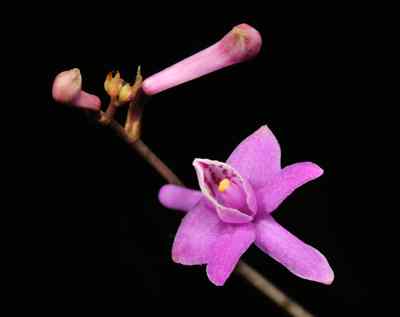The Plant
Terrestrial, but often found growing as lithophyte also. Pseudo bulb small, ovoid, partially buried in the ground (if terrestrial). Stem narrow, 6 to 18 cm long, sheathed at the base. Leaves 2 to 6, many nerved, long, with parallel edges and pointed apex, sessile, base sheathing, 6 to 15 cm long and 1 to 1.5 cm in width. Flowers in peduncle arising from the lower side of the pseudo bulb, longer than the leaves, 1 or rarely more, raceme very rarely branched. Ovary ribbed and long stalked, with a narrow lanceolate, clasping floral bract arising from its lower side.
The Flower
Flowers many, 5 to 24, laxly arranged. Non-resupinate. Flowers 1.5 to 2 cm across with long-stalked ovary. Sepals unequal, dorsal oblong; lateral ovate, twice wider than the dorsal; connate at their bases to form a narrow cylindric tube. Petals oblong, smaller than the lateral sepals, the base attached inside the tube. Sepals and petals single veined. The base of the lip attached to the column, tubular, apex wide open.
Sepals and petals rose to pink coloured. The mouth of the lip white, disc and side lobes with many pinkish dark spots, anther a brilliant yellow, ovary pinkish brown, floral bract brown.

The Pursuit
As the monsoon settles down in the month of August, the open land, slopes, rocks of the sub-tropical forests are full of this species. They cover the entire area and within few weeks start blooming. Its blooming phenomenon continues for two more months thus enabling a wide range of audience to enjoy its beauty. I had spotted these plants in plenty by the end of monsoon from many locations and waited for them to bloom.
Even though widely documented, the colour variations and markings inside its lip were not properly documented earlier. Hence, I decided to document this species in detail for further references. As the flower is non-resupinate, with its lip pointing upwards, the dark markings on its disc is apparently invisible with all published photographs. Hence, I decided to take a low angle shot to make those markings visible. For the same I was looking for a few plants growing at a height of about 6 to 7 ft from the ground with its stem erect and stretching outward. Even though the species was in plenty in that location, one with all features of my imagination was difficult to find. After a couple of hours of search I found a few plants growing on a rock next to a small stream. The plants were on the outer side of the rock and projecting outwards. Their height was also very much suitable for my low angle shots. Stepping into the knee-deep water of that small stream I produced this low angle shot of the species with full details of its disc markings and colour variations.
Reference:
Anthogonium gracile Lindl., Page no 96 – 97 of The Orchids of the Sikkim-Himalayas by Sir. George King and Robert Pantling (1898).